Looking for something to give a little oomph to your garden? The Alocasia Black Velvet plant is the perfect exotic indoor Aroid. Its heart-shaped black leaves with white to silvery veins make any garden look royal and more mesmerizing.
Interested? Learn more about this black beauty’s care and propagation by reading this article.
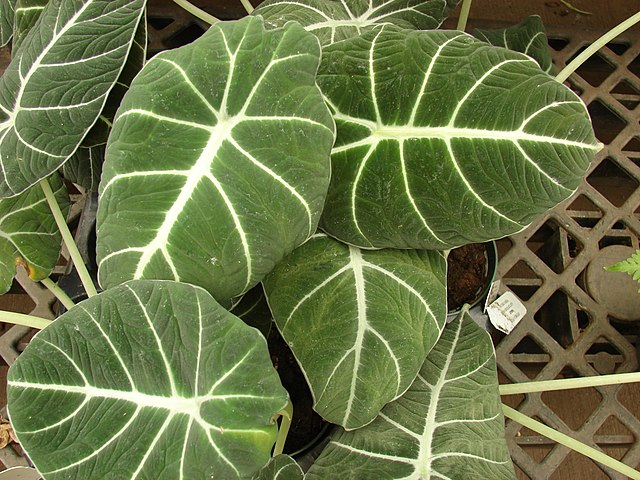
Alocasia Black Velvet Profile
General Information
Alocasia reginula, commonly called Black Velvet, is a miniature of a dwarf Jewel Alocasia. Its height ranges from 13cm to 15cm, while its width is around 18cm to 25cm. It is still not clear where the parentage of this plant is, but according to some opinions, it was collected in 1860 from Borneo, East Asia.
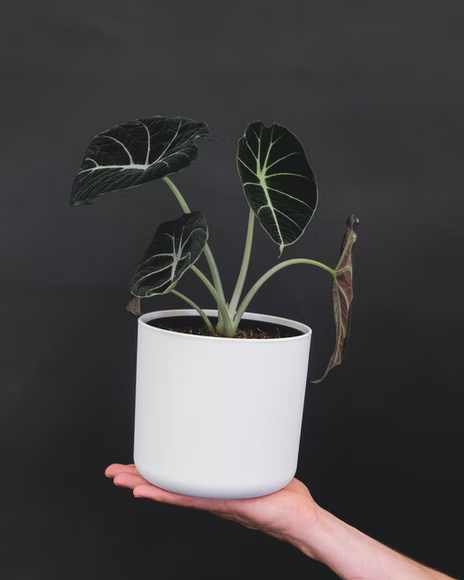
People are usually mesmerized by the Black Velvet’s foliage which gave its common names Black Velvet elephant ear plant, Alocasia Velvet, the little Queen, and Queen Alocasia.
Although the surface of Black Velvet leaves is black, the underside has pale splashes or spots, and the stem is pale and thick. The plant body is also branched and rhizomatous, which gives it an overall appealing structure.
Etymology
The species earned its nickname ‘The little queen’ or ‘The Black Dwarf Queen’ due to its small size and the regal appearance of its velvety, black, and silver leaves.
Flowering
The Black Velvet may bloom throughout the year, given that its growing conditions are favorable. Its flowers are anthurium-like, consisting of a white sterile finger-like spadix surrounded by a pale yellow petal/modified leaf known as its spathe.
Season of Interest And Purchasing
The Alocasia Black velvet plant actively grows during spring and summer and goes into dormancy during the winter. However, dormancy does not mean it is dead. Instead, think of it as the hibernation of plants. This will end up rightfully when the temperatures rise again.
Growth
Black Velvets are fast-growing plants. So naturally, they thrive in tropical climates under canopies of trees. Therefore, it best grows under indirect light. It also favors humid conditions, just like the forests of its origin.
RELATED: Alocasia Nebula: All the Must-Have Care, Propagation and Watering Guide
Alocasia reginula ‘Black Velvet’ Overview
| Scientific name | Alocasia reginula ‘Black Velvet’ |
| Common name/s | Black Velvet, Queen Alocasia, Alocasia Velvet, Little Queen |
| Family | Araceae |
| Growth Habit | Herbaceous |
| Height and Spread | 13 cm – 15 cm in height (maximum 50 cm), mature leaves up to 17 inches. |
| Classification based on life cycle | Perennial |
| Origin and Distribution | Obscure origin. Native range in Borneo. Commercially available around the world. |
| Climate Zone | Generally warmer climate |
| USDA Plant Hardiness Zone | USDA Zone 9 – 11 |
| Color | Velvety black with platinum veins |
Care Tips
Light Requirement
Bright, indirect light is recommended for the Alocasia Black Velvet plant. It can also grow and absorb light energy under artificial light at a minimum height of 40cm. Direct sunlight exposure should always be avoided as it may scorch its leaves. Too much light will not give you a healthy plant.
Temperature Requirement
Keeping this tropical plant nice and warm throughout summer and winter is essential. Ideally, it should be kept between a temperature range of 50 to 80 degrees Fahrenheit. If you live in colder places where these temperatures can not be naturally reached, Black Velvet can be placed under a heating system.
Just make sure that they are not in close contact with fans, ACs, and winds, as they are sensitive to strong winds and drifts.
Water Requirement
Despite thriving in a humid environment, the Black Velvet is extremely sensitive to water. In addition, the black velvet has several rhizome roots which can easily absorb too much water. Therefore, it is recommended that this plant is watered around 3 times per week during warm seasons, reducing it to once weekly during colder seasons.
Assisted and careful watering is a must to maintain the beautiful black foliage of this alocasia plant. Do not let it stay in wet soil conditions to avoid root rot.
Humidity Requirement
Since the Black Velvet plant prefers high humidity levels, it can be placed in humid locations like your bathroom or kitchen area. During dry days with low humidity, misting and using a humidifier or a pebble tray may be done to provide adequate moisture. Just make sure that these plants’ velvety leaves are not wet for too long.
Too much humidity also leads to root rot, fungi-related diseases, and infestation of many pests such as spider mites, scales, and mealybugs. These pests and microorganisms thrive in humid environments.
Soil Requirement
Loamy, sandy soils that are well-drained with large particles go well with this plant. Standard jungle mix or widely available aroid mix also do well. Overly moist soil is a no-no for this Alocasia. The potting soil must have proper aeration and drainage to preserve a sound root system.
Fertilizer Requirement
The Black Velvet Alocasia is a food-loving plant. Therefore, experts recommend supplementing the plant with fertilizer or plant food from the beginning to ensure that it starts strong in life.
Fertilizers have different, specific formulas, so it is essential to look at the products’ individual guidelines to know how frequently you should be fertilizing your Alocasia plant. If the plant is looking a bit limp without any other explanation, it may signify that your plant needs a feeding boost. An essential houseplant fertilizer that is water-based can be used.
Remember that the Black Velvet sleeps during the winter months, so if it looks a bit wilted during this season, there is no need to give it any food. Furthermore, too much fertilizer is not suitable for this alocasia species as it causes fertilizer burn.
Space Requirement
Since it only grows around 30-40 cm, Alocasia black velvet does not need ample space to grow. It’s the perfect addition to a desk, apartment living room, or bathroom.
Growing And Planting Tips
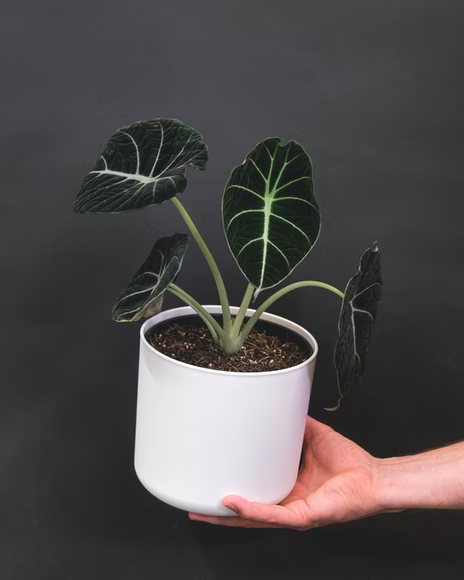
Propagation
Alocasia black velvet is commonly propagated through rhizome division. The ideal growing season is in the middle of winter. Additionally, they can also be propagated through readily available seeds in the market. However, this process takes relatively longer.
To propagate Alocasia Black Velvet, select a healthy mother plant. Dig the soil, around 12cm, and gently take out a rhizome and split it. Make sure the rhizome system is intact. This division may then be planted into moist, rich, or lightly fertilized soil. Give them enough space to grow, around 50cm between each plant, especially if you are planting to keep them in one pot.
After these 4 simple steps, you can now place the pot in a warm, humid place with readily available indirect sunlight. Avoid overwatering and make sure it is getting its optimal requirements. You will expect to see a tiny new plant growth after a month, and after about three months, a well-grown plant will be achieved.
Nowadays, Black velvet is heavily propagated by tissue culture for mass production.
Pruning
There is no regular pruning needed for this black beauty. Removing the damaged, yellowing leaves and dusting them off by gently spraying a small amount of water is enough. To avoid excess water on thick leaves, which can lead to damage, use a dampened cloth to wipe them down after spraying.
Potting And Repotting
Rhizomes generally don’t grow quickly. Thus, the black velvet plant is not usually re-potted until around 2 years. Standard Jungle Mix or Aroid Mix can also be used to re-pot the plant. Peat moss, orchid bark, coco coir, and perlite are also recommended for the potting mix to make way for air pockets that will keep roots aerated and avoid standing water.
Alocasia reginula ‘Black Velvet’ Care
| Light | Bright indirect |
| Temperature | 50 – 80 degrees Fahrenheit |
| Water | Once a week, increased in summer, decreased in winter |
| Soil | Well-draining and organic, loamy/sandy recommended |
| Fertilization | Once a month, no fertilization needed in winter |
| Space | Minimal space |
| Propagation | Via rhizome division |
| Blooming | Rarely blooms, enough sunlight and maturity needed |
| Pruning | When needed, removal of damaged and decaying leaves |
| Potting | Regular potting mix or Aroid mix, use of perlite and peat moss recommended, |
Pests And Diseases
Alocasia Reginula ‘Black Velvet’ Pests And Diseases
| Common Pests/Diseases | Symptoms | Treatment and Prevention |
Common diseases include leaf spotting, root rotting, fungal diseases, stem and crown rotting. | Black or dark brown spots with yellow rim around | Do not overwater and maintain proper humidity levels. Extremely wet environments enhance fungal growth.Proper ventilation is necessary. Removal of infected plant parts to avoid spreading of disease. |
| Common pests include aphids, scales, mealybugs, spider mites | Visible insects thriving on surface | Warm, soapy water can be sprayed once a month. Neem oil, herbal spray, or commercial insecticides can also be used. |
RELATED: Alocasia Sarian: Ultimate Care Guide, Propagation, and More
Problems And Troubleshooting
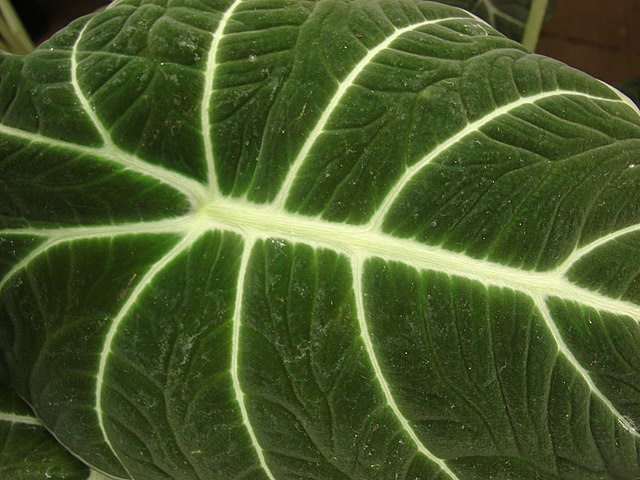
Overwatering
Knowing if your tropical plants are overwatered is through their leaves and roots. General drooping of the leaves is one, as well as wet feet and yellowing, watery blisters, edema, and brown spots that can be seen on the surfaces of the leaves. Overwatering may also cause root rot which can manifest as a particular smell, especially on the base of the plant.
To avoid overwatering, make sure that the watering frequency of your Alocasia is correct and proper. It is also important to note that it is getting its minimum requirements, such as a well-draining moist soil, bright indirect light, and a specific moisture level.
In addition, avoid planting it in a large pot and make sure that the drainage holes are not more significant than the plant by 1-2 inches when re-potting. Add coco coir and peat moss to your potting soil. This will avoid soggy soil conditions. Finally, move the Alocasia plant to a location where a suitable range of light and humidity is present.
Underwatering
Underwatered Alocasia plants are generally easier to notice. Brown edges and crispy leaf tips of the leaves, and a cracky upper soil are the usual indicators that your plant is not getting enough water.
To avoid this, eliminate possible factors that contribute to underwatering. It may be helpful to check the plant’s pot size to ensure its ideal growing zone. Paying attention to the plant’s needs is critical. Direct sun also makes the water evaporate quickly, making the soil dry. Ensure that proper bright light, which is indirect, is given.
Nutrient Deficiency
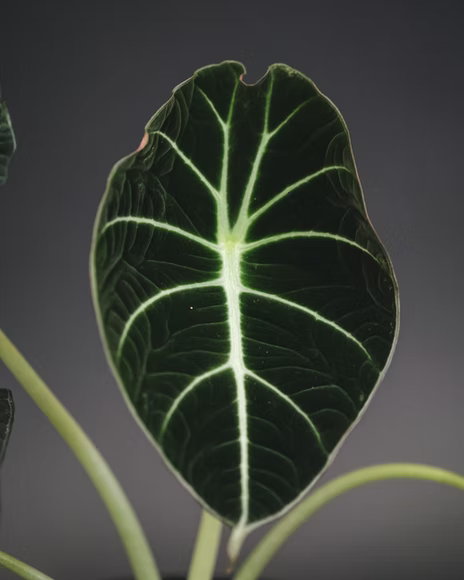
Common nutrient deficiencies in other plants do not exclude this exotic plant. Nutrient deficiencies usually manifest as yellowing of leaf surfaces or crispy edges, holes, burnt leaves with brown tips, purplish hues on leaves, brown spots, distorted leaves, soft texture, and stunted roots.
To fix this, the right and balanced fertilizer must be used. A nutrient strength that is too strong may also be as detrimental as nutrient deficiency, so this should be kept in check. Soil pH is also essential since it is a significant factor in the plant’s nutrient uptake.
Flowering Problems
Alocasia plants generally do not have regular flowering seasons; thus, it helps to not rely on flowering time. To ensure that your plants produce flowers, ensure that optimum care and requirements are given, significantly sufficient lighting, which is crucial for flowering.
Problems with People and Animals
Toxicity
The foliage and stem of Alocasia plants contain calcium oxalate crystals which can induce irritation and swelling in the throat and mouth of humans and animals. These irritations and swelling may cause death due to airway blockage in the worst-case scenario.
RELATED: Alocasia Maharani: Helpful Plant Information and Care Guide For This Rare Beauty
Alocasia Plants Meaning And Symbolism
Alocasias are said to be “trees that grow up to the heavens”, even though botanically speaking they are not trees. With this, black velvet symbolizes seizing opportunities and taking risks. They are perfect gifts for people who are about to make major life decisions such as moving into a new city or venturing into a new business.
Alocasia reginula ‘Black Velvet’ Symbolism and Meaning
| General Meaning | “plant that grows up to heavens” |
| Symbolism | Risk taking and seizing opportunities |
| Cultural Significance | Attribution to the Jack and the Beanstalk fairytale |
Landscaping And Gardening Ideas
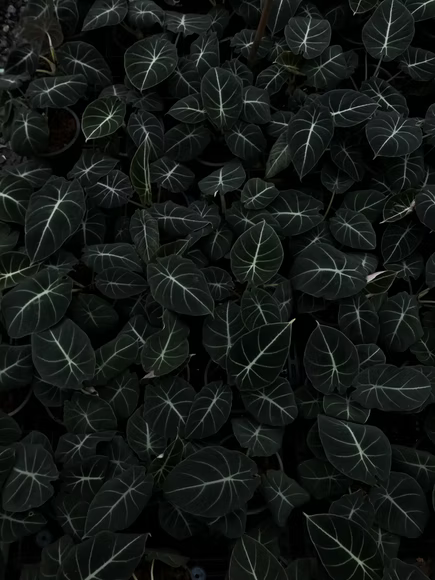
Companion Plants
Other Alocasia plants such as Silver Dragon and African Mask, Caladiums, Colocasia, and Xanthosoma make great companions to these plants. In addition, many plants like Canna lilies, decorative bananas, Dieffenbachia, Ficus, Schefflera, and Coleus, may also be with Alocasias as they exude the same tropical scenery vibe.
Landscaping Ideas
In gardens, Alocasias can be on the perennial borders. Its foliage, shaped like elephant ears, is a good break from the rest of the plants, especially those with colorful hues. In terrariums and vivariums, it can be in the center with other foliage and flowering plants.
This plant with dark leaves can also be with plants with purple hues or stiff texture, which provide more drama when juxtaposed with the dark green leaves of Alocasias.
| What to plant with | Colocasia, Caladiums, Alocasias, Xanthosomas, Coleus, Canna Lilies, Ornamental Bananas, Ficus, Dieffenbachia, Schefflera |
| What NOT to plant with | Basically nothing |
Conclusion
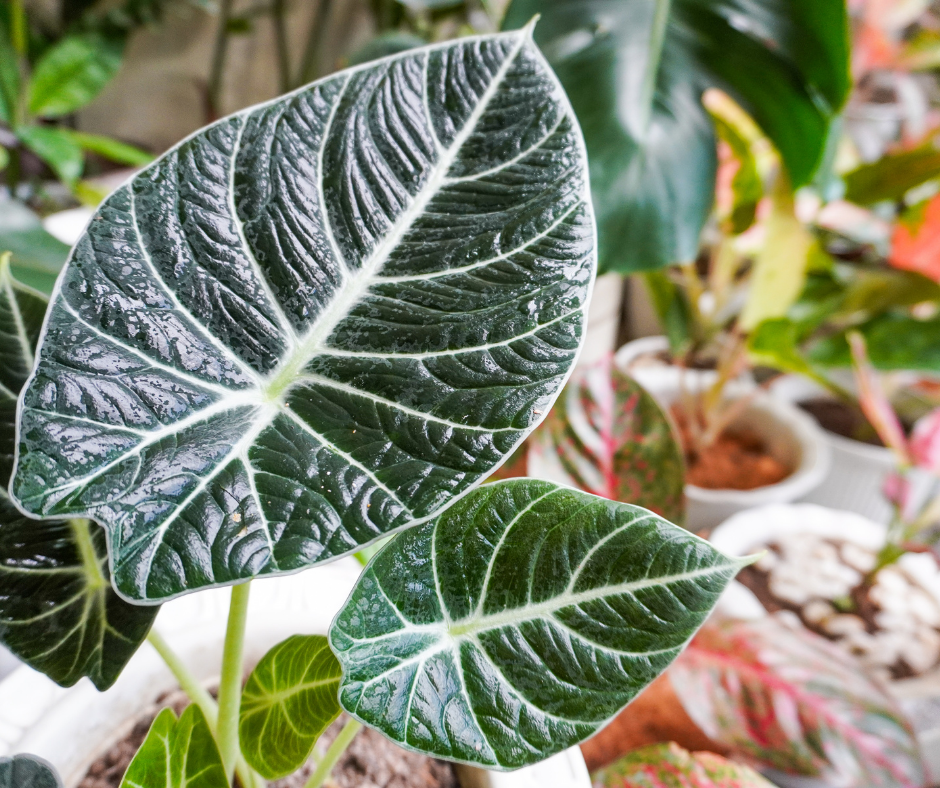
Alocasia black velvet is an excellent addition to your indoor plant collection or even a starter to your lonely desk or cute bathroom. Caring for this plant might not be the easiest for beginners, but it is manageable. Admittedly, it is pretty high-maintenance–she is a queen, after all!–but is overall easy to grow given the proper attention.
Frequently Asked Questions
Are Alocasia Black Velvet hard to care for?
Black Velvet Alocasias are not the easiest to care for, but surely not the hardest. The plant needs reasonable care and attention to thrive and could be a little fussy when the environment is not at its optimum. However, first-time plant collectors can still have this in their homes.
Should I cut off the Alocasia Black Velvet flower?
It depends on you. You can leave the flower and admire its rare beauty. However, flowers take much energy from the plant, and thus often, flowering involves the dropping of some leaves. Cut the flowers off if you care for much healthier foliage and faster new growth, especially in the growing season.
How often should you water Black Velvet Alocasia?
Black Velvets are very water sensitive. Therefore, it is imperative to water this Alocasia only once during cold seasons and up to three times a week during hot seasons. As a general rule, you may check the top 3 inches of soil and only water when it is scorched. Overwatering causes too moist conditions that will invite more spider mites and microorganisms.
Does Black Velvet Alocasia bloom?
As an angiosperm, Alocasias produce an anthurium-like flower called a spadix. However, the flowers of Alocasias are insignificant as they rarely bloom. They are collected mainly by their distinct foliage.
What soil does a Black Velvet Alocasia need?
A well-draining soil that contains large chunks which are suitable for aeration and drainage is what Black Velvet loves. A standard jungle or aroid mix will surely make your Black Velvet thrive.
We hope you learned something from this article, here are other articles that you can learn from:
Snake Plant Roots: What To Look For In A Healthy Sansevieria Plant
How To Grow & Care For Your Monstera Plant? The Ultimate Guide
Syngonium Variegata: The Best and Complete Care, Propagation, and Watering Guide







